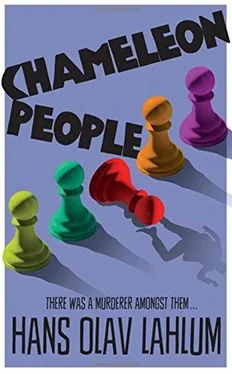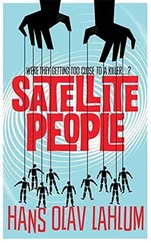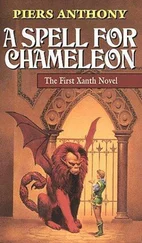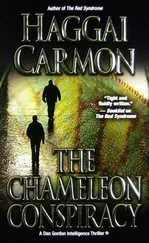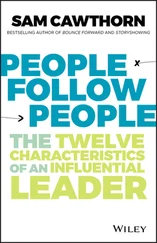There were no teenagers living in the building that I knew of and I was sure that I had never seen the cyclist before. So I stayed where I was and watched him slow down and then lurch, rather than leap, from the bike only a few metres from the apartments. The bicycle lay abandoned in the middle of the path, as the cyclist ran on towards the door.
Even though my mind was not working at full capacity, I did notice that the young cyclist had a terrible limp in his right leg as he struggled with the final stretch, and that he was exhausted and disoriented. I wondered for a moment which of the residents this apparently desperate and rather dubious character might know, and was very thankful that it was not me.
Then the doorbell rang.
It echoed around the flat – then rang three more times with only a few seconds’ interval in between.
I went to the door, but stopped and hesitated. The idea of pretending I was not there was very tempting indeed.
While I dithered, the bell rung for a fourth and fifth time. And the fifth ring sounded to my ear like a long cry of anguish.
Suddenly this brought to mind the very unpleasant incident on the Lijord Line two years before, when I had seen the carriage doors close in front of a terrified young woman, who was then found dead on the tracks later that evening. It was an awful experience that I did not wish to repeat, so I swiftly picked up the intercom and asked who it was.
‘Let me in! They’re after me! I have to talk to you before they get me!’
His voice was ragged, gasping and shrill with fear, but did not mask the fact that the boy had a speech impediment.
I hesitated again for a fraction of a second. Then I looked out of the window and saw the car.
It was a big car with no lights, and it sped up the hill through the dark in an almost aggressive manner towards the abandoned bike.
The sight of the car made me spontaneously press the door-opener, and over the intercom system I heard my unexpected guest tumbling in downstairs.
Seconds later, I had opened the door to my flat. The boy on the red bicycle was by then clattering up the stairs towards me. He tripped on the last step and ended up prostrate and panting on the landing. I as good as dragged him into the flat and slammed the door shut.
It never occurred to me that my uninvited visitor might be dangerous. The boy was empty-handed, thin, just over five foot, and on top of that, completely done in by his frantic flight. He lay on the floor by my doormat for a few seconds, gasping for breath.
‘Who is after you?’ I asked.
Just then there was another ring on the bell.
I looked down at him and hastily repeated my question. His answer was a shock.
‘The police.’
I asked him if he knew that I was a policeman.
He gave a feeble nod and a sheepish smile.
There was yet another ring on the doorbell. It was longer and louder this time.
I kept my eyes trained on my young guest, as I picked up the intercom.
This time I recognized the familiar voice of a constable. He said that a suspect had disappeared into my building and asked if everything was under control inside.
I answered yes and once again pressed the door-opener.
My guest remained seated on the floor, but had now managed to catch his breath again.
‘I had to speak to you before they caught me,’ he said.
His voice was almost a whisper and was drowned out by heavy steps on the stairs.
‘And what did you want to tell me?’ I asked.
‘That I’m innocent,’ he whispered.
And then it was as if he had said all he wanted to say. He sat there quietly on the floor by the doormat, without another word.
I opened the door when they knocked and assured them that everything was under control. ‘They’ being three slightly puffed policemen, who briefly shook my hand.
I watched them put handcuffs around my guest’s skinny wrists. He did not resist in any way, and suddenly seemed utterly disinterested in what was going on.
The young man had one striking physical feature: a reddish-brown birthmark that covered the greater part of the right-hand side of his neck. Of course, that could not help us identity him there and then. And there was nothing in the boy’s pockets that could tell us who he was. In fact, we found very little of interest. But the one thing we did find was both damning and alarming.
The boy on the red bicycle had a sharp kitchen knife in the left pocket of his jacket and both the handle and the blade were sticky with blood.
I realized then that the situation was serious indeed, but still did not join up the dots until one of the policemen heaved a sigh of relief and remarked: ‘You’ve truly outdone yourself this time, DI Kolbjørn Kristiansen. You have single-handedly caught Fredriksen’s murderer without even leaving your flat!’
I spun round and asked the policeman if Per Johan Fredriksen had died. He looked at me gravely and replied that the politician had been declared dead at the scene. He had been stabbed straight through the heart. It was done efficiently and apparently with a good deal of hate.
Given this information, I looked at the boy on my floor with some scepticism. He did not avert his eyes or blink.
‘I didn’t kill him. He was dead when I went back,’ was the only thing he said.
And he then repeated this three times.
After the third, one of the policemen commented laconically that they could categorically dismiss his statement that Fredriksen had been dead when he got there. Two witnesses who were passing had seen the young man standing at a street corner in Majorstuen as the politician walked by. The young man had been visibly agitated, whereas Fredriksen had calmly exchanged a few words with him, and then carried on.
A few minutes later, the young man had been seen bending over Fredriksen further down the same block, with the knife in his hand. He then fled when three further witnesses rounded the corner. It had taken them a few minutes to contact the police and alert any patrol cars in the area. However, one of them had then spotted the fleeing cyclist in the quieter roads around Hegdehaugen.
We all looked sharply at the young arrestee.
‘I didn’t kill him. He was already dead when I went back,’ he said yet again in a staccato voice.
He fixed me with a remarkably steady and piercing look when he said this.
Then he closed his lips tight and turned his dark eyes to stare pointedly at the wall.
It occurred to me that I had never come across such a clear-cut murder case. And yet the adrenalin was pumping given the evening’s unexpected and dramatic turn in my own home, and the case was not closed yet, as the murderer’s identity and motive were unknown. It struck me as rather odd that the young man had known where I lived. And it was quite simply mystifying that he had chosen to flee here, having murdered a top politician. Consequently, I accompanied them in the car down to the main police station.
It did not take long to drive there. The arrestee sat squashed between myself and a constable in the back seat, small and silent. In contrast to the explosive energy and will he had demonstrated only half an hour earlier, he now seemed not only resigned, but as good as disinterested in everything. As we drove past his bicycle, he asked if someone would look after it, then gave a curt nod when I said that it would of course be taken down to the police station. After that, he said nothing more.
I sat and looked at our prisoner for the first part of the journey. The conspicuous birthmark on his neck was close to my shoulder and drew my attention again. I had a strong intuition that this birthmark would in some way be significant to the case, without having a clue of how, what or why.
Читать дальше
